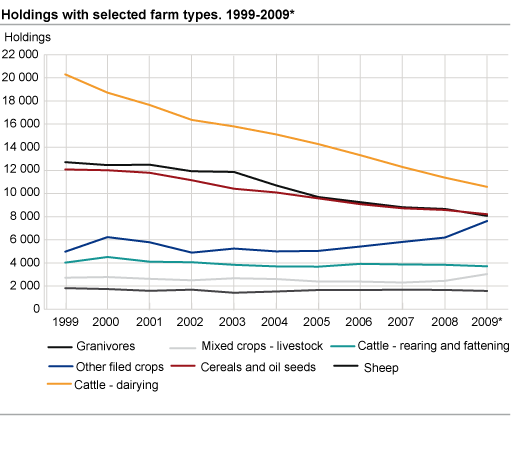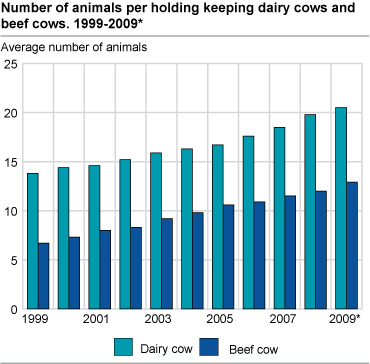Content
Published:
This is an archived release.
Fewer farms with milk production
Preliminary figures from Statistics Norway show that the number of holdings with cattle dairying was 10 600 in 2009, of a total of 48 800 holdings. Since 1999, the number of cattle dairy holdings has almost halved.
The total agricultural area in use was 10.15 million decares in 2009. The area of meadows for mowing and pastureland covered 6.6 million decares in 2009, and the total grain area amounted to 3.1 million decares.
In 2009, 45 000 holdings were operated by natural persons, while 3 000 were operated by various legal persons, e.g. joint operations, limited companies and institutions. Since 1999 the number of holdings being operated by a legal person has raisen from 1.1 per cent to 6.3 per cent of all holdings.
38 500 of the personal holders were males and 6 400 female ones. From 1999 to 2009 the average age of holders has increased from 48 to 50 years of age.
Holdings can be classified by type of farming. From 2008 to 2009, the number of farms with cattle dairying as main activity dropped by 7 per cent. The number of farms with sheep or grain and oil seed as the main activity fell by 7 and 4 per cent respectively. These three activities are the dominating types of farming in Norwegian agriculture.
From 2008 to 2009, the number of holdings with dairy cow dropped by 7 per cent to 10 600. The number of dairy cows fell by 4 per cent to a total of 239 400. Since 1999, the number of dairy cows has been reduced by 24 per cent. In the same period, the number of beef cows has increased by 29 700 to 66 500, an increase of 81 per cent. The average herd has increased from 13.8 dairy cows and 6.7 beef cows in 1999 to 20.5 dairy cows and 12.9 beef cows in 2009.
Tables:
- Table 1 Total number of holdings and holdings by type of holder
- Table 2 Personal holders by age. Per cent. Average age
- Table 3 Holdings by size of agricultural area in use and county
- Table 4 Agricultural area per holding, by county. 1979, 1989, 1999-2009*. Decares
- Table 5 Agricultural area, by use. 1979, 1989, 1999, 2006-2009*. Decares
- Table 6 Domestic animals. 1979, 1989, 1999, 2006-2009*
- Table 7 Number of animals per holding keeping various kinds of animal, by county and size of holding
- Table 8 Holdings, by type of farming. 2000-2009*
Additional information
Agricultural holdings on grids (1km, 5km)
Contact
-
Berit Bjørlo
E-mail: berit.bjorlo@ssb.no
tel.: (+47) 40 81 13 76


